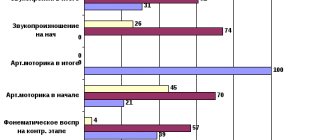A frequent speech disorder in children is phonetic-phonemic underdevelopment - a violation of the processes of formation of the pronunciation system of the native language in children with various speech disorders due to defects in the perception and pronunciation of phonemes. This category includes children with normal hearing and intelligence.
This is a whole complex of phonetic-phonemic disorders, including violations:
- phonemic hearing;
— phonemic analysis;
- phonemic synthesis;
- phonemic perception;
- phonemic representations;
Phonetic-phonemic underdevelopment is the basis for the occurrence of dysgraphia and dyslexia - a persistent lag in the ability to write and read.
Phonemic hearing is a subtle, systematized hearing that has the ability to carry out operations of discrimination and recognition of phonemes that make up the sound shell of a word. Phonemic hearing helps to distinguish some speech sounds from others (zh-sh), (b-p), (z-s), to distinguish by ear syllables and words that differ only in one sound (sa-xia) (zhi-shi), due to which words are distinguished, recognized and understood, for example: house-som-crowbar-com-barrel-kidney-fishing rod-duck-rat-roof.
The development of phonemic hearing occurs very early and is ahead of the child’s expressive speech in its development, i.e. First, phonemic hearing is formed, and on its basis speaking itself is formed.
If phonemic hearing is impaired, the child perceives (remembers, repeats, writes) not what he was told, but what he heard - some exactly, and some very approximately. “Needle” turns into “mist,” “forest” into “leaf” or “fox,” “Misha’s car” into “mice on a car.” The child “does not hear” the endings of words or paired consonants. It is difficult for him to repeat chains of syllables, even with oppositional sounds (ta-pa-ka, ta-da), and it is difficult for him to choose pictures that differ by one sound in the names (bear-mouse, barrel-kidney).
Lack of phonemic awareness is especially pronounced when learning to write and read.
Phonemic analysis and synthesis are mental activities of analyzing or synthesizing the sound structure of a word.
Phonemic analysis is the ability to break down an audible word into its constituent sounds and clearly imagine its sound structure. Phonemic analysis refers to mental actions to analyze the sound structure of a word - decomposing it into a sequential series of sounds, counting their number, classification.
The most complex form of phonemic analysis is determining the sequence of sounds in a word, their quantity, and place in relation to other sounds (after which sound, before which sound). This form of sound analysis appears in children only in the process of special literacy training. Underdevelopment of language analysis and synthesis is manifested:
When writing, distortions in the structure of words and sentences. Particularly common in this case will be distortions of the sound-letter structure of the word. The most typical errors are: omissions of consonants when they are combined (dictation - “dikat”, school - “kola”); vowel omissions (dog – “sbaka”, house – “dma”); permutations of letters (path - “torpa”, window - “kono”); adding letters (taskali - “tasakali”); omissions, additions, rearrangement of syllables (room - “kota”, glass - “katan”).
When reading specific errors:
omissions of consonant sounds when converging (brand - “maka”, barrel - “sides”),
insertion of vowels between consonants when they come together (pasla - “pasala”, girl - “girl”),
permutations of sounds (duck - “tuka”, croup - “kurpa”)
omissions and insertions of sounds in the absence of a combination of consonants in a word (milk - “milk”, raspberries - “maalina”).
For proper mastery of the processes of writing and reading, the formation of phonemic analysis is very important.
Phonemic synthesis is the ability to combine individual sounds into a whole word with subsequent recognition of this word, mentally composed of sounds. Phonemic synthesis refers to mental actions to synthesize the sound structure of a word - the merging of individual sounds into syllables, and syllables into words.
A child who knows how to synthesize sounds into a word should be able to answer a question like: “What word will come from these sounds: k-o-sh-k-a?” (sounds are pronounced one at a time, with pauses between them).
Omissions and rearrangements of letters, the addition of extra letters when writing are often evidence of unformed phonemic synthesis. Only with free orientation in the sound composition of a word will a child be able to master writing at the proper level.
Phonemic perception is special mental actions involving the differentiation of phonemes and the establishment of the sound structure of a word.
Phonemic awareness is the ability to perceive the sound composition of a word. How many syllables are in a word? How many sounds does it have? What consonant sound comes at the end of a word? What is the vowel sound in the middle of a word? It is phonemic awareness that helps answer these questions.
Formed phonemic perception is the key to clear pronunciation of sounds, the correct syllabic structure of words and the basis for the ease of mastering the grammatical structure of the language, and therefore the successful development of writing and reading.
Children usually learn the basic sounds of language quite early. Due to the physiological characteristics of the structure of the articulatory apparatus, they cannot correctly reproduce all phonemes of their native language, but at the same time they are well aware of the subtlety of pronunciation. At this time, the child is already beginning to hear the sounds of the language in accordance with their phonetic characteristics. He recognizes mispronounced words and is able to differentiate between correct and incorrect pronunciation. At the age of 5-6 years, children should already have a high level of development of phonemic perception. They must correctly form subtle and differentiated sound images of words and individual sounds.
Children with good phonemic awareness speak clearly because they clearly perceive all the sounds of our speech. At the same time, in children with underdeveloped phonemic perception, not only sound pronunciation suffers, but also speech understanding, since they cannot separate phonemes that sound similar, and words with these phonemes sound the same to them, for example: sami-sleigh, kidney-barrel, fox (animal) - forests (plural of the word “forest”).
In general, a violation of phonemic perception leads to the fact that the child does not perceive speech sounds that are close in sound or similar in articulation. His vocabulary is not replenished with words that contain sounds that are difficult to distinguish. The child gradually begins to lag behind the age norm. For the same reason, the grammatical structure is not formed to the required extent. It is clear that with insufficient phonemic perception, many prepositions or unstressed endings of words remain “elusive” for the child.
Unformed phonemic perception, on the one hand, negatively affects the development of children's sound pronunciation, on the other hand, it slows down and complicates the formation of sound analysis skills, without which full reading and writing are impossible. The use of special techniques for the development of phonemic processes leads to the fact that children perceive and distinguish the endings of words, prefixes, common suffixes, highlight prepositions in a sentence, etc., which is so important when developing reading and writing skills.
The ability to hear each individual sound in a word, to clearly separate it from the next one, to know what sounds the word consists of, that is, the ability to analyze the sound composition of a word, is the most important prerequisite for proper literacy learning.
Phonemic representations are images of the sound shells of words preserved in the mind, which were formed on the basis of previous perceptions of these words.
To fully master reading and writing, it is not enough to be able to differentiate speech sounds only at the moment of their immediate auditory perception. It is necessary that the child retains a stable idea of each sound in his memory, that is, he can mentally imagine the sound of any sound. During independent reading and writing, he can correlate each sound with its corresponding letter only on the basis of such mental ideas about sounds - after all, at this time he does not have the ability to perceive these sounds by ear.
Underdevelopment of phonemic representations leads to difficulties in mastering the process of reading and writing, specific persistent errors in reading and writing, and, consequently, to failure in school, and a number of behavioral and psychological problems.
It is possible to form appropriate phonemic representations only with the help of special correction techniques.
Not only children with FPD experience underdevelopment of phonemic hearing and perception, but also children with ODD levels I-IV, with dysarthria, dyslalia, alalia, dysgraphia, dyslexia.
It should be noted that phonemic perception in the process of ontogenesis occurs at certain stages:
Complete lack of differentiation of speech sounds. No understanding of speech. The stage is defined as prephonemic;
It becomes possible to distinguish between acoustically distant phonemes, while acoustically close phonemes are not differentiated. A child hears sounds differently than an adult. Distorted pronunciation probably corresponds to misperception of speech. There is no difference between correct and incorrect pronunciation;
The child begins to hear sounds in accordance with their distinctive features. However, a distorted, incorrectly pronounced word is associated with the object. The coexistence of two types of linguistic background: the former, tongue-tied and the formative new one.
Expressive speech is almost normal, but phonemic differentiation is still unstable, which manifests itself in the perception of unfamiliar words.
The completion of the process of phonemic development, when both the perception and expressive speech of the child are correct. A sign of transition is the distinction between correct and incorrect pronunciation.
In my work with children, I use special exercises to develop phonemic hearing and phonemic perception.
In the work on the formation of these processes, the following stages can be distinguished:
Stage I – recognition of non-speech sounds;
Stage II - distinguishing the height, strength, timbre of the voice on the material of identical sounds, words, phrases;
Stage III – distinguishing words that are similar in their sound composition;
Stage IV – differentiation of syllables;
Stage V – differentiation of phonemes;
Stage VI – development of basic sound analysis skills.
Sample games and exercises that I use in my work:
For example, when working on recognizing non-speech sounds, I use the computer method “Development and correction of speech of children 4-8 years old (Akimenko V.M.)” to develop auditory attention, distinguish non-speech sounds (the game “What sounds?”), I also use various toys and objects for the game “Guess what sounds” (the game uses objects that can produce characteristic sounds: bell, drum, paper, pipe, keys, etc.)
Game “Which word is different?”
Of the four words clearly pronounced by an adult, the child must name the one that differs from the rest: ditch-ditch-cocoa-ditch, com-com-cat-com, duckling-duckling-duckling-kitten, booth-letter-booth-booth, screw-screw-bandage-screw, minute-coin-minute-minute buffet-bouquet-buffet-buffet, ticket-ballet-ballet-ballet, pipe-booth-booth-booth.
Exercise “Name the first sound in words” (A, O, I, U).
Stork, duck, needle, queue, vegetables, snail, morning, pharmacy, army, album, search, leave, play, groan, gasp, Africa, India, harvest, sparks, turkey, matinee, address, Aibolit, aquarium, antelope, washbasin, island.
Exercise “Name the last sound in words” (A, O, I, U, Y).
Head, game, wall, leg, hat, thread, bench, pen, watering can, window, coat, cinema, a long time ago, wing, move away, name it, carry, lights, streams, books, pies, poppies, shovels, bouquets, lemons, ribbons, candy, I’m going, I’ll call, I’ll hug, cockatoo, I’ll throw, I’ll shout, I’ll go, I’ll spin, I’ll come.
Exercise “Name all the sounds in order”
Buck, hall, var, your, howled, din, goal, hum, gift, smoke, house, shower, beetle, heat, lump, cat, whale, crowbar, varnish, onion, poppy, soap, small, moss, nose, our, steam, dust, floor, cancer, mouth, dug, rum, himself, juice, bitch, son, dream, soup, litter, current, so, knock, choir, jester, ball.
When automating sounds, I always include tasks to determine the position of a sound in a word (at the beginning, in the middle, at the end). Children especially love the game with the train (1 car - the sound "hid" at the beginning of the word, 2 car - in the middle of the word, 3 car - at the end of the word).
In many classes, my children and I come up with words with given sounds: at the beginning, in the middle, at the end of the word.
If the child accurately completes all tasks at all stages and masters the concepts of “sound, syllable, word,” then we move on to the most complex tasks, for example, drawing up word diagrams. The child learns to characterize sounds (vowels, consonants, hard and soft consonants, voiceless and voiced) and draw diagrams of words.
Thus, we see that phonemic processes are formed in the child gradually. Phonemic hearing is a basic element of speech activity and needs to be developed.
Bibliography:
Speech therapy: Textbook for students of defectology. fak. ped. universities / Ed. L.S. Volkova, S.N. Shakhovskaya. —— M.: Humanite. ed. VLADOS center, 1998. - 680 p.
Tkachenko T. A. Development of phonemic perception. Preschooler's album: A manual for speech therapists, educators and parents. M.: GNOM i D, 2005.
Tkachenko T. A. Speech therapy notebook. Development of phonemic awareness and sound analysis skills. – St. Petersburg: DETSTVO-PRESS, 2000. – 32 p.
Phonemic analysis and synthesis in ontogenesis
A. N. Gvozdev believes that the function of the child’s auditory analyzer is formed early, much earlier than the speech motor analyzer. Already in the second week of life, the child, hearing the sounds of a voice, stops sucking; stops crying when people start talking to him. He early distinguishes the sounds of the human voice and responds to this stimulus, depending on the intonation, either with a smile or a cry.
From 6 months, by imitation, he pronounces individual phonemes, syllables, imitating tone, tempo, rhythm, melody and intonation.
By the age of 2, children begin to distinguish quasi-homonym words (paronyms). By this age, the formation of phonemic hearing ends, as evidenced by the child’s phonemic discrimination of all the sounds of his native language. He is able to distinguish words by sound that differ by one phoneme.
In the process of early speech development, expressive and impressive speech are closely related: on the one hand, speech development stimulates auditory perception, on the other hand, it clarifies one’s own pronunciation.
conclusions
Thus, the following conclusions can be drawn:
- The function of the child’s auditory analyzer is formed early, much earlier than the speech motor analyzer.
- Phonemic hearing consists of the ability to generalize different sounds into separate groups, to combine sounds, taking as a basis some essential features and ignoring other, random features.
- The process of speech perception is divided into two stages: prephonemic and phonemic.
- N. Kh. Shvachkin identifies 12 phonemic series according to the order of formation in children.
- Of all types of analysis of speech flow (dividing sentences into words, words into syllables, syllables into sounds), the most difficult is the phonemic analysis of words.
- Practical ideas about the sound composition of a language are formed on the basis of phonemic analysis and perception. Memory and attention play a significant role in this process.
Stages of speech perception
N.H. Shvachkin divides the process of speech perception into 2 stages:
- prephonemic (from birth to 1 year);
- phonemic (after one year, respectively).
Prephonemic stage. The child does not distinguish between phonemes and the sound-syllable structure of a word. At this stage, the child’s sound complex has several meanings. In other words, up to 1 year of age, the semantic load is carried not by the phoneme, but by the intonation, rhythm, and general sound pattern of the word. Moreover, up to 6 months, intonation plays a leading role, and at the 6th month, rhythm takes on a semantic orientation.
Phonemic stage. “Phonological development occurs rapidly, constantly ahead of the child’s articulatory capabilities, which serves as the basis for improving pronunciation.” Until this moment, the child recognized words by sound pattern, and from that moment he began to distinguish phonemes. First, contrasting ones, then complex ones, and lastly distinguishes between acoustically similar ones.






